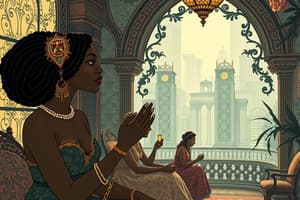Podcast
Questions and Answers
What was one of the key reasons for the migration of African Americans to Harlem during the Harlem Renaissance?
What was one of the key reasons for the migration of African Americans to Harlem during the Harlem Renaissance?
- Lack of cultural activities in downtown Manhattan
- Strict segregation laws in downtown Manhattan
- Availability of affordable housing and better opportunities (correct)
- Higher concentration of brothels and gambling dens
How did Phillip A. Payton Jr. contribute to the migration of African Americans to Harlem?
How did Phillip A. Payton Jr. contribute to the migration of African Americans to Harlem?
- Organized resistance against the migration of African Americans
- Enforced strict segregation laws in Black Bohemia
- Negotiated deals with white landlords to lease apartments to middle-class blacks (correct)
- Encouraged the establishment of more brothels and gambling dens in Harlem
What led to tensions between white and black communities in Harlem during the Harlem Renaissance?
What led to tensions between white and black communities in Harlem during the Harlem Renaissance?
- Government policies promoting racial integration
- Harmony and cooperation among all residents in Harlem
- Resistance from white residents against the influx of black tenants (correct)
- Shared living spaces and resources
Why did the African-American Realty Company face challenges during the Harlem Renaissance?
Why did the African-American Realty Company face challenges during the Harlem Renaissance?
Who played a significant role in supporting black writers and artists during the Harlem Renaissance?
Who played a significant role in supporting black writers and artists during the Harlem Renaissance?
Which event celebrated African-American literature and provided support for black writers in 1924?
Which event celebrated African-American literature and provided support for black writers in 1924?
Which publication involved collaboration between Langston Hughes, Wallace Thurman, Zora Neale Hurston, Aaron Douglas, and Gwendolyn Bennett?
Which publication involved collaboration between Langston Hughes, Wallace Thurman, Zora Neale Hurston, Aaron Douglas, and Gwendolyn Bennett?
Who became a prominent jazz soloist in the 1920s?
Who became a prominent jazz soloist in the 1920s?
Which white establishment in Harlem was known for its jungle decor and all-black reviews?
Which white establishment in Harlem was known for its jungle decor and all-black reviews?
What led to the decline of the Harlem Renaissance and a shift in focus to Chicago as a cultural capital in the 1930s-1950s?
What led to the decline of the Harlem Renaissance and a shift in focus to Chicago as a cultural capital in the 1930s-1950s?
Flashcards are hidden until you start studying
Study Notes
- The Harlem Renaissance was a significant part of the Black Renaissance cultural movement in the early 20th century, characterized by a flourishing of African-American culture in literature, art, theater, and music.
- Harlem became a cultural mecca for black Americans, attracting residents from Black Bohemia in downtown Manhattan due to better living conditions and opportunities.
- Black Bohemia was a ghetto for African Americans, characterized by overcrowding, high rent prices, and the prevalence of brothels and gambling dens.
- Phillip A. Payton Jr. played a crucial role in the migration of African Americans to Harlem by negotiating deals with white landlords to lease apartments to middle-class blacks.
- Tensions between white and black communities in Harlem escalated as white residents organized to resist the influx of black tenants, leading to evictions and property disputes.
- The African-American Realty Company faced challenges from the Property Owners Protective Association, leading to its failure, prompting retaliation by Philip A. Payton Jr. and others to buy properties and install black tenants.
- The Harlem Renaissance marked a period of heightened black pride and a shift towards embracing authentic black cultural expressions in music, art, literature, and theater.
- Charles Spurgeon Johnson, a sociologist, played a key role in promoting and supporting black writers and artists during the Harlem Renaissance, working to break down racial barriers in the literary world.
- Johnson's efforts culminated in events like the Civic Club Dinner in 1924, which celebrated African-American literature and provided a platform for recognition and support for black writers.
- The Harlem Renaissance saw the emergence of influential black writers like Langston Hughes, Wallace Thurman, Zora Neale Hurston, Aaron Douglas, and Gwendolyn Bennett, who collaborated on publications like "Fire" magazine.
- The artistic disagreements and controversies within the Harlem Renaissance, such as the reception of Carl Van Vechten's novel "N**** Heaven," highlighted differing views within the black community on how black life should be portrayed in literature.- Blues music spread to new audiences in the 1920s, with artists like Bessie Smith gaining fame.
- Jazz originated from blues, migrating to urban centers like Chicago and New York after World War One.
- Jazz orchestras grew in size and popularity in the 1920s, with Louis Armstrong becoming a prominent jazz soloist.
- The Savoy Ballroom in Harlem was a popular jazz club, hosting famous musicians like Duke Ellington and Cab Calloway.
- The Cotton Club, owned by a gangster named Owney Madden, was a famous white establishment in Harlem known for its jungle decor and all-black reviews.
- Acceptance of jazz among white audiences led to the "Negro Vogue," where it became fashionable to visit Harlem nightclubs.
- African American representation in theater improved in the 1920s, with more dramatic roles becoming available for black actors.
- The Harlem Renaissance saw a rise in African American art, with artists like Meta Warrick Fuller and Aaron Douglas challenging racist social norms.
- The Great Depression in 1929 had a significant impact on Harlem, leading to economic hardship and a decline in the Harlem Renaissance.
- The decline of the Harlem Renaissance led to a shift in focus to Chicago as a cultural capital for black America in the 1930s-1950s.
Studying That Suits You
Use AI to generate personalized quizzes and flashcards to suit your learning preferences.




